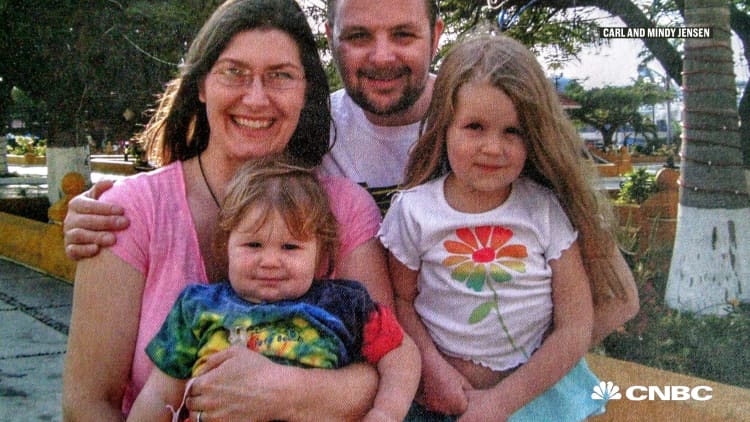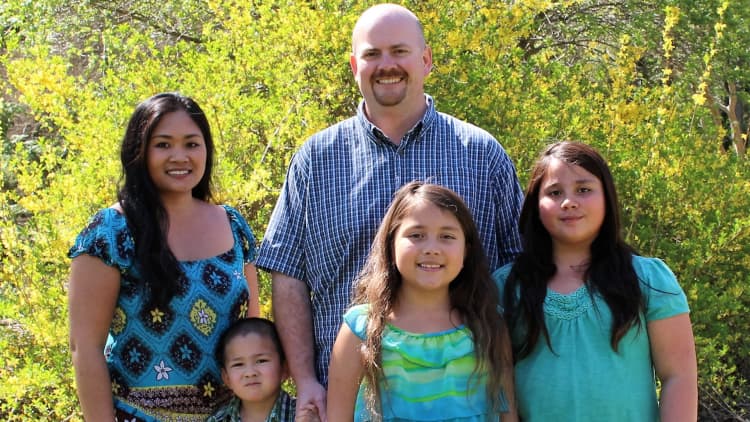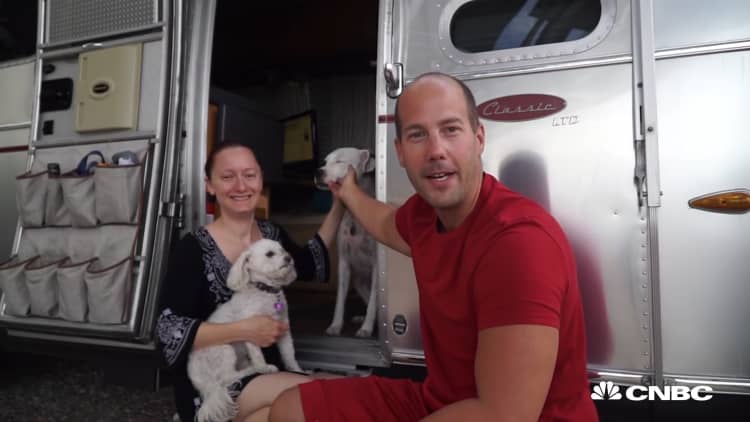Steve Adcock wasn't always thrifty. "Through my 20s and early 30s, I was one of the masses. I wanted the nice cars, big houses and expensive 'stuff,'" he writes on his blog, ThinkSaveRetire.
"I made good money, but I only saved the bare minimum. I spent the rest."
It wasn't until 2014 that he and his wife Courtney decided to double down on their savings in order to retire early.
"About a year after we got married, we really started to put the wheels in motion," Steve tells CNBC Make It. "It slowly started to sink in that we could put this dual income into our savings and investments and retire early, rather than spend it all now and continue working just to maintain that lifestyle."
In December 2016, Steve left his career in information technology at age 35. Courtney joined him in early retirement in April 2017.
Shortly after, the couple left their home-base in Tuscon, Arizona, to travel the country full-time in a 30-foot Airstream trailer.
Their lifestyle "no longer depends on any source of income," Steve writes. "Any money that we bring in by working for fun is icing on the cake."
Here's a look at exactly how they made early retirement a reality:
They figured out how much they were going to spend in retirement
"The first thing we had to do was take a look at how much we thought we were going to spend [in retirement]," says Steve.
It's a common first step among early retirees, who not only think about what they want their future lifestyle to look like but also project how their spending will change.
Next, Steve and Courtney used the "4 percent rule" to determine how big their portfolio would need to be to last through their golden years. The rule says that in most cases you can safely withdraw 4 percent a year from your retirement savings portfolio.
For safety, the Adcocks plan to spend about 3 percent of their total net worth each year.
They tracked their expenses and cut their spending
Once the Adcocks had an idea of just how big their portfolio needed to be, they got serious about slashing their spending. They started by tracking all of their purchases in an Excel spreadsheet.
"We know exactly what we bring in and exactly what we spend … and on what," writes Steve. "Knowing where our money goes is critical to maximizing our savings and pinpointing where we could probably cut back."
They cut back a lot. "For the most part, we went cold turkey," Steve tells CNBC Make It. "We cut out everything that we didn't think was necessary."
That included Steve's biggest vice: dining out. "We only went out to eat once or twice a month, and I love going out to eat," he says. "But the way we thought about it was: Is this spending worth another month of working? And more times than not, the answer was, 'Oh, heck no.' It made it really easy to say no to certain things."
At the end of the day, "I don't like restaurants enough to work for the next 30 years of my life," says Steve.
They downsized
In addition to eliminating restaurant tabs and other unnecessary day-to-day expenses, the Adcocks cut back on the big ticket items.
For starters, they sold most of their possessions and traded in their 1,600 square-foot house with a pool for an Airstream, where they've been living full-time since April 2016.
The savings are drastic. They bought the trailer with cash, Steve tells CNBC Make It, meaning they don't have a mortgage. Plus, "there's no property tax, and when you're out in the middle of nowhere, like we are now, there's not even rent.
"As long as you can bring your own water and have solar power, there's absolutely no cost to stay on the land. This lifestyle can be as cheap as you want it to be."
The Adcocks also sold their 1999 Corvette Convertible and Honda Ridgeline.
The couple now spends about $30,000 a year. Their biggest monthly expenses are now diesel and health care, which costs $250 per person per month.
They saved up to 70 percent of their income
Thanks to cutting back on their day-to-day expenses and downsizing, the couple managed to set aside up to 70 percent of their income, which ranged from $200,000 to $230,000 a year.
"We banked Courtney's income entirely and lived off about 50 percent of mine," Steve tells CNBC Make It.
While the two made good money, their success boiled down to learning how to spend less rather than figuring out how to make more. "Never assume income and retirement are tied at the hip," Steve writes. "It is almost always easier to retire early based on a high level of savings than a high level of income."

They put their money to work
The Adcocks didn't just save a ton of money; they put their money to work.
"Just saving doesn't get you rich," Steve tells CNBC Make It. "That's definitely a good start — you do need to save — but what gets you wealthy is investing that money."
Both Steve and Courtney maxed out their employer sponsored retirement plans when they were working. And Courtney's entire salary went straight to their investment portfolio.
Want to fast-track your retirement like the Adcocks? Focus on the "prize," says Steve, and ask yourself "if another year of working for a living is worth that shiny new thing."
Like this story? Like CNBC Make It on Facebook.
Don't miss: How one couple saved $1 million in 4 years to retire by age 43




